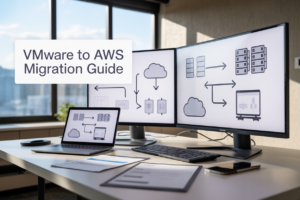Public AWS S3 buckets expose sensitive data to the entire internet, putting your organization at serious risk. This guide targets DevOps engineers, security professionals, and AWS administrators who need to identify and secure exposed S3 buckets using bash scripting AWS techniques.
We’ll walk through building effective S3 security audit scripts that scan for vulnerable buckets across your infrastructure. You’ll learn how to create automated S3 bucket enumeration tools using bash AWS CLI commands to detect S3 data exposure before attackers find it.
First, we’ll cover the essential bash tools and AWS CLI setup you need for comprehensive S3 security monitoring. Then, we’ll build practical scripts that identify public S3 buckets and assess their security posture. Finally, we’ll explore advanced automation techniques to continuously monitor your AWS cloud security and respond quickly to new exposures.
Understanding S3 Bucket Security Risks
Public bucket exposure consequences for businesses
Exposed S3 buckets create massive vulnerabilities that can destroy businesses overnight. When AWS S3 public buckets leak sensitive data, companies face immediate reputation damage, customer trust erosion, and competitive disadvantage. Real-world breaches have exposed millions of customer records, internal documents, and proprietary code through misconfigured S3 bucket security settings, proving that even tech giants aren’t immune to these devastating exposures.
Common misconfigurations that lead to data breaches
Default bucket permissions often grant broader access than intended, creating security gaps that attackers exploit. Developers frequently misconfigure bucket policies, accidentally enabling public read/write access during testing phases and forgetting to restrict permissions before production deployment. Cross-account policies, overly permissive IAM roles, and disabled bucket encryption represent the most dangerous S3 security audit findings that lead to unauthorized data access.
Financial and legal implications of unsecured data
Data breach costs average $4.45 million per incident, with regulatory fines adding millions more under GDPR, CCPA, and HIPAA frameworks. Public S3 bucket exposures trigger mandatory breach notifications, legal investigations, and class-action lawsuits that drain resources for years. Companies face stock price drops, insurance premium increases, and potential business closure when AWS cloud security failures expose customer data or trade secrets to competitors and malicious actors.
Essential Bash Tools for S3 Security Auditing
Installing and configuring AWS CLI
First, grab the AWS CLI from Amazon’s official site or use your package manager. For Ubuntu/Debian systems, run sudo apt install awscli, while macOS users can use brew install awscli. Windows users should download the MSI installer. After installation, verify everything works by typing aws --version in your terminal. The AWS CLI serves as your primary gateway for S3 bucket security auditing and bash scripting AWS operations.
Setting up proper authentication credentials
Configure your AWS credentials using aws configure command, which prompts for your Access Key ID, Secret Access Key, default region, and output format. Store sensitive credentials in ~/.aws/credentials file with appropriate permissions (600). Consider using IAM roles with minimal required permissions for S3 security audit tasks. For enhanced security, enable MFA and use temporary credentials through AWS STS when possible.
Required bash utilities and dependencies
Your S3 bucket enumeration toolkit needs several bash utilities. Install jq for JSON parsing (sudo apt install jq), curl for HTTP requests, and grep for pattern matching. The parallel command accelerates bulk operations, while xmlstarlet helps parse XML responses. These tools work together to create powerful AWS security monitoring scripts that can identify public S3 buckets efficiently across multiple regions and accounts.
Testing your environment setup
Validate your setup by running aws s3 ls to list accessible buckets. Test JSON parsing with aws s3api list-buckets | jq '.Buckets[].Name'. Create a simple test script that queries bucket policies using aws s3api get-bucket-policy. Check connectivity to different AWS regions and verify your credentials have sufficient permissions for security auditing. This verification step prevents authentication errors during actual S3 data exposure detection operations.
Building Your S3 Bucket Discovery Script
Listing all buckets in your AWS account
Start your S3 security audit by retrieving all buckets using the AWS CLI: aws s3 ls provides a complete inventory of your S3 resources. This basic command forms the foundation for comprehensive bash scripting AWS security monitoring. Export the bucket list to a variable with buckets=$(aws s3api list-buckets --query 'Buckets[].Name' --output text) to enable automated processing and further security analysis across your entire AWS environment.
Checking bucket policies and ACL permissions
Examine bucket configurations using aws s3api get-bucket-policy and aws s3api get-bucket-acl commands to identify S3 bucket security vulnerabilities. Create a bash function that loops through each bucket, parsing JSON output for public permissions. Look for “AllUsers” or “AuthenticatedUsers” principals in policies, and check ACL grants for public read/write access. This systematic approach helps identify public S3 buckets that pose potential data exposure risks.
Identifying publicly accessible buckets
Build detection logic by examining bucket policy statements for "Principal": "*" and "Effect": "Allow" combinations. Check for public ACL permissions using aws s3api get-bucket-acl --bucket $bucket --query 'Grants[?Grantee.URI==http://acs.amazonaws.com/groups/global/AllUsers`]’`. Your bash script should flag buckets with public list, read, or write permissions. Cross-reference bucket policies with ACL settings for comprehensive S3 data exposure assessment and accurate security reporting.
Creating automated detection functions
Develop modular bash functions for S3 bucket enumeration and security scanning. Create check_bucket_public() function that combines policy and ACL analysis, returning boolean values for public access status. Implement error handling for access-denied scenarios and rate limiting to prevent API throttling. Structure your functions to accept bucket names as parameters, enabling reusable code for ongoing AWS security monitoring across multiple accounts and regions.
Advanced Detection Techniques with Bash
Scanning for public read permissions
Check S3 bucket public read access using aws s3api get-bucket-acl and get-bucket-policy-status commands. Parse JSON output with jq to identify AllUsers or AuthenticatedUsers permissions. Create bash loops to iterate through bucket lists, filtering for READ access grants that expose your data to unauthorized users.
Detecting public write access vulnerabilities
Public write permissions pose severe security risks for S3 bucket security. Use aws s3api get-bucket-acl --bucket bucket-name --query 'Grants[?Grantee.URI==http://acs.amazonaws.com/groups/global/AllUsers`]’` to detect dangerous write access. Combine with policy analysis using get-bucket-policy to catch overly permissive IAM policies enabling unauthorized uploads.
Finding buckets with overly permissive policies
Identify S3 buckets with excessive permissions by analyzing bucket policies and access control lists systematically. Use AWS CLI commands within bash scripts to extract policy documents, then parse JSON for wildcards, broad principal statements, and unrestricted actions. Focus on policies allowing s3:* actions or containing "Principal": "*" statements that bypass intended access controls.
Automating Security Monitoring
Scheduling Regular Security Scans
Cron jobs offer the most reliable way to run S3 security audits automatically. Set up daily scans using 0 2 * * * /path/to/s3-audit-script.sh to check for public buckets during off-peak hours. Weekly comprehensive scans can include deeper analysis of bucket policies and ACLs. Store scan results in timestamped directories for historical tracking and trend analysis.
Setting Up Alerts for Newly Created Public Buckets
Real-time monitoring catches newly exposed S3 buckets before they become security incidents. Configure AWS CloudWatch Events to trigger your bash script when bucket policies change. Use AWS SNS integration to send instant notifications via email or Slack when public access gets enabled. The script should compare current bucket states against previous snapshots to identify changes accurately.
Creating Comprehensive Audit Reports
Professional audit reports transform raw scan data into actionable security intelligence. Your bash script can generate HTML reports with color-coded risk levels, bucket creation dates, and exposure timelines. Include metrics like total public buckets discovered, data volume at risk, and compliance violations. Export findings to CSV format for integration with security dashboards and executive reporting tools.
Integrating with Existing Security Workflows
Security teams need S3 monitoring that fits their current processes seamlessly. Configure your bash scripts to output findings in SIEM-compatible formats like JSON or CEF. Set up webhook integrations with tools like Jira for automatic ticket creation when high-risk exposures get detected. API endpoints can feed S3 security data directly into security orchestration platforms for automated remediation workflows.
Remediation Strategies for Exposed Buckets
Safely securing public buckets without breaking applications
When securing exposed S3 buckets, test changes in a staging environment first. Create bucket policies that restrict access while maintaining application functionality. Use AWS CloudTrail to monitor access patterns before implementing restrictions. Apply the principle of least privilege by granting only necessary permissions to specific users or services. Always coordinate with development teams to understand application dependencies before modifying bucket permissions.
Implementing proper access controls
Replace public read permissions with targeted IAM policies and bucket ACLs. Use AWS S3 bucket policies to define specific IP ranges, VPC endpoints, or IAM roles that can access your data. Enable S3 Block Public Access settings at both account and bucket levels for comprehensive protection. Configure Cross-Origin Resource Sharing (CORS) rules carefully to prevent unauthorized cross-domain access while supporting legitimate application needs.
Validating security changes
Run your bash S3 security audit scripts after implementing changes to verify buckets are no longer publicly accessible. Test application functionality thoroughly using automated testing suites and manual verification. Monitor AWS CloudWatch metrics for access denied errors that might indicate overly restrictive policies. Document all security modifications and create rollback procedures in case applications break unexpectedly after bucket security updates.
Protecting your organization’s data starts with knowing what’s exposed. The Bash techniques covered in this post give you the power to scan, detect, and monitor your S3 buckets without relying on expensive third-party tools. From basic bucket discovery to advanced automation scripts, you now have a complete toolkit for identifying security gaps before they become costly breaches.
Don’t wait for a data leak to make headlines with your company’s name. Take action today by running these scripts against your AWS infrastructure. Set up automated monitoring to catch misconfigurations as they happen, and create a regular audit schedule to stay ahead of potential threats. Your data’s security is only as strong as your ability to see what’s vulnerable.




















